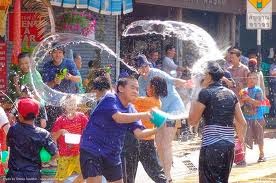The Monkey Buffet Festival
The monkey buffet festival is a celebration that takes place in Thailand and it´s held every November 25th. The local peoples believe that monkey´s bring good fortune to the visitors. It has been held done since 1989, and it main public are the tourist from different parts, which offers proximally 4000 kilograms of food and drinks every year. It has also representative music and dances and different activities throw-out the day with young people dress like monkeys, as a shown of thanks because of they great value. As well it has become a very important colorful tradition to the Thailand people because the meaning of the monkeys, and the worth goals. (Alexandra)
The monkey feast is the ingenious concept of a hotelier, Yongyuth Kitwattananusont, who first feted the monkeys in 1989. Now, with the sponsorship of Thailand’s Tourism Authority, his spectacle attracts thousands of tourists. Yongyuth attempts to outdo himself each year. He once stuffed himself into a monkey suit and arrived via parachute. The November of 1999, he promises to up last year’s offering: 4,000 kilograms of food. A longstanding second-tier tourist draw, Lop Buri is the site of 10th-century Hindu temples built by a Khmer dynasty. The main temple, strongly resembling the architecture of Cambodia’s Angkor Wat, is headquarters for the macaques. (Sebastian)
As the name of the festival itself indicates, this is a festival where the monkeys along with the food are the protagonists. In Thailand, there is the belief that King Rama gave a piece of land known as Lopburi to Hanuman who was the Monkey King. For that reason, nearly 2000 monkeys each year receive thousands of pounds of food (like fruits and desserts) in a big table where public enjoy seeing them. People from Thailand also believe, thanks to their history, that monkeys bring good fortune so this is also made in their honor. Besides of being a local celebration, the monkeys attract a lot of tourists and the country receives benefits with the visits. (Miguel)
In this festival the ones who enjoy the buffet are the monkeys them self. They enjoy with a large buffet of food, ranging from sweet desserts to fruits, vegetables, and sodas. In the monkey buffet you can watch the monkeys drink coke directly from the can. In the past years the monkeys have consumed over four tons of food, not many people are agree with the type of diet that this monkeys have on this event, but what it is a fact is that this animals certainly enjoy their annual special meal. (Maria Ximena)
This bunch of things make this festival a colorful and a very happy event, it has a variety of delicious odors, and a very beautiful, green landscape, that is why it is recommendable for any kind of people, it doesn’t matter you will have a pretty good time and you will enjoy your stance in here every minute. (Sopia)
.jpg)
.jpg)
.jpg)
.jpg)
.jpg)
.jpg)
.jpg)
.jpg)




.jpg)
.jpg)
.jpg)
.jpg)

.jpg)











.jpg)
.jpg)
.jpg)
.jpg)








.jpg)